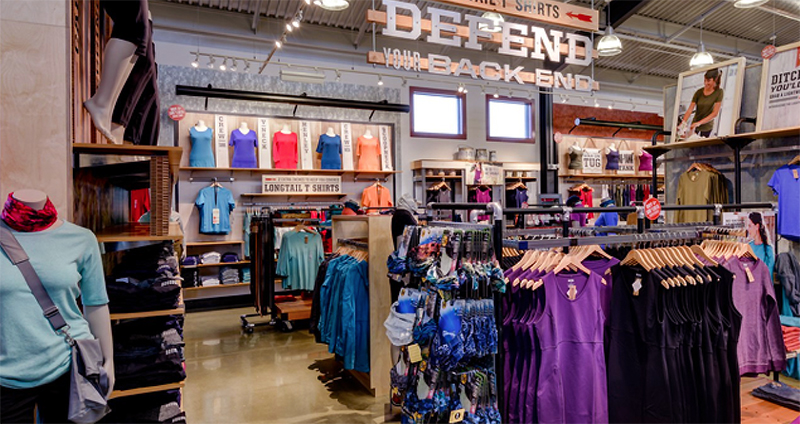<span style="color: #a6a6a6;">Duluth Holdings Inc., the parent of Duluth Trading, delivered significant improvements in earnings in the second quarter as sales grew 12.6 percent, led by online sales. Said Steve Schlecht, executive chairman and CEO, on a conference call with analysts, “Comfort was key.”
Net sales increased to $137.4 million from $122.0 million in the prior-year second quarter. Direct-to-consumer (DTC) or online/catalog sales increased 66.9 percent while store sales decreased 40.4 percent.
Net income increased to $5.9 million, or 18 cents per share, more than double the $1.9 million, or 6 cents, earned in the prior-year second quarter.
“We’re far from taking a victory lap in the COVID environment yet I can clearly see the Duluth Trading story playing out according to our long term strategy,” said Schlecht on the call. “Our company was built on three brand pillars: solution-based design, humorous and distinctive marketing, and outstanding and engaging customer experience that continues to set us apart, regardless of the competitive landscape.”
The increase in the DTC sales was driven by a shift of existing customers to online, as well as new buyer growth, particularly within its women’s products. Total new buyer growth increased by 54.6 percent year-over-year.
Schlecht said the online growth was support by past investments in an enhanced website and mobile capabilities “that easily accommodated a surge in demand.” Site visits increased 34 percent, mobile traffic grew 42 percent and sales from mobile doubled versus the comparable period. A shift to focus more on digital marketing helped drive online sales and led to a 130 percent lift in new buyers online.
The decrease in store sales was due to the temporary closure of all stores due to COVID-19. Store re-openings ranged from the first week in May through the third week in June.

Schlecht did note that the company saw DTC growth of 80 percent in store markets, outpacing non-store markets, demonstrating the importance of retail stores in building brand awareness and expanding its customer base. Schlecht said, “When in-store shopping was curtailed by the pandemic, customers readily adapted to online shopping. The ultimate value of a true and strong omnichannel is that a retailer does not lose precious customers, but it offers an alternative path to purchase.”
Twenty-six percent of digital orders in the quarter were fulfilled by stores.
<span style="color: #a1a1a1;">Sales in non-store markets increased $17.3 million, or 58.6 percent, primarily due to an increase in digital advertising to promote Mother’s Day, Father’s Day and online warehouse clearance events. Sales in-store markets decreased $1.6 million, or 1.8 percent, due to temporary store closures, partially mitigated by a 79.8 percent increase in DTC sales in store markets.
By gender, men’s category sales increased 15.3 percent, driven by growth in men’s underwear, Alaskan Hardgear and apparel newness. Schlecht said the men’s strength was driven by the “newness factor” with a recently-launched swimwear line accounting for close to 18 percent of total men’s sales for the quarter.
Women’s sales expanded 9.6 percent, fueled by the Summer Solved collection, comfortable basics and plus-line apparel. No-Yank Tank, baselayers, yoga, and outdoor favorites like gardening and overalls were “especially strong” in women’s, according to Schlecht.
Gross margin decreased 30 basis points to 52.8 percent. The decrease was primarily driven by promotional, clearance and sitewide sales events to continue moving inventory during the period of slower store traffic and uncertainty in customer demand. The decrease was partially offset by reduced store delivery costs from lower store sales volumes as well as favorable retail physical inventory count results year over year.
SG&A expenses increased 2.6 percent but were reduced as a percent of sales to 45.6 percent from 50.1 percent. The positive leverage was primarily due to shifting to a more efficient digital marketing approach as customer purchasing patterns migrated to online. The net increase in SG&A expense was due to increased shipping costs to support website sales, higher retail overhead costs driven by new store growth and increased depreciation expenses associated with investments in technology, partially offset by reduced catalog spend and national TV advertising.
Operating income increased to $9.8 million from $3.7 million in the prior-year quarter. Adjusted EBITDA soared 75.3 percent to $16.8 million.
The company ended the quarter with a cash balance of $19 million, $49.5 million outstanding on its $70.5 million term loan, and $30 million outstanding on its $80 million revolving line of credit. Inventories were at $167.6 million at the quarter’s end, up from $147.9 million at the start of the year and $114.8 million at the same time last year.
Looking ahead, Duluth said the due to the uncertainty in the marketplace, it has reduced its planned capital spend levels from the beginning of the fiscal year by 50 percent to $15 million primarily by decreasing new store openings this year to four and deferring certain technology and infrastructure projects, as well as continuing to focus on managing expense, extending payment terms and adjusting inventory receipt plans.
Schlecht said Duluth will ramp up digital marketing in the back half to support the launch of its new 40 Grit collection that targets younger shoppers and remain“focused on doing our level best to keep the momentum going” in a challenging retail climate. He said, “We already anticipate that steep discounting will continue, holiday deals will begin even earlier and shipping networks will be constrained by increased volume.”
Photos courtesy Duluth Trading Company
















